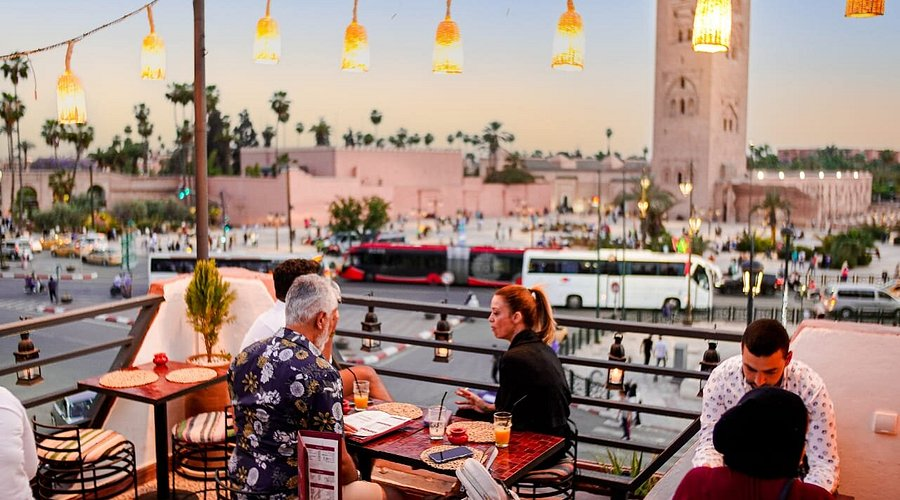Picture yourself wandering through a labyrinth of narrow alleyways, where the air is thick with the aroma of sizzling meats, freshly baked bread, and exotic spices. Welcome to Marrakech, Morocco’s gastronomic capital, where every meal tells a story thousands of years in the making. This comprehensive guide will take you on a culinary journey through the Red City’s finest offerings, from hidden gems in the medina to sophisticated restaurants in modern Gueliz.
The Soul of Moroccan Cuisine: A Cultural Tapestry
Marrakech’s culinary identity is like a finely woven carpet, with threads of various cultural influences creating a unique and intricate pattern. The city’s food scene is a testament to centuries of cultural exchange, where Berber traditions meld seamlessly with Arab sophistication, Andalusian finesse, and French colonial influences.
The Spice of Life
Step into any spice shop in the souks, and you’ll be transported into a world of color and aroma. The foundation of Moroccan cuisine rests on these key spices:
- Cumin: The earthy backbone of many dishes
- Coriander: Both fresh and dried, adding citrusy notes
- Cinnamon: A warm touch in both savory and sweet dishes
- Saffron: The “red gold” of Morocco, prized for its distinctive flavor and color
- Ras el hanout: A proprietary blend that can contain up to 30 different spices

The Art of Slow Cooking
The tagine, Morocco’s iconic conical clay pot, is more than just cookware—it’s a philosophy. The slow-cooking process allows tough cuts of meat to become tender while vegetables absorb the rich, aromatic broth. Each tagine tells its own story:
- Lamb with prunes and almonds: A celebration of sweet and savory
- Chicken with preserved lemons and olives: A citrusy dance of flavors
- Fish tagine with chermoula: A coastal tribute with herbs and spices
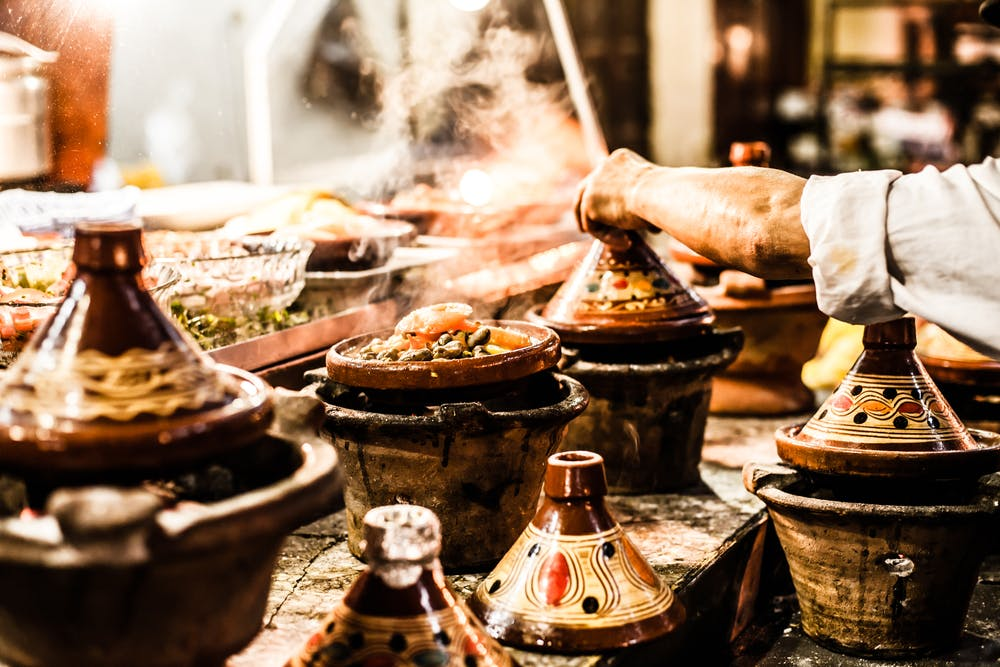
Morning Glory: Breakfast in Marrakech
Breakfast in Marrakech is a celebration of simplicity and flavor. As the city awakens, the streets fill with the scent of freshly baked bread and brewing mint tea.
Essential Morning Delights
- Msemen: Watch as skilled hands fold and flatten this buttery, layered bread. The best versions have a crispy exterior that gives way to a chewy, multi-layered interior. Drizzle with honey or dip in amlou for a truly Moroccan start to your day.
- Baghrir: These semolina pancakes, riddled with tiny holes like a sponge, are perfect vehicles for butter and honey. The holes allow the toppings to seep through, creating pockets of flavor in every bite.
- Khobz: This round flatbread is the foundation of Moroccan meals. Fresh from the communal ovens, it’s perfect for scooping up eggs seasoned with cumin and traditional breakfast dips.
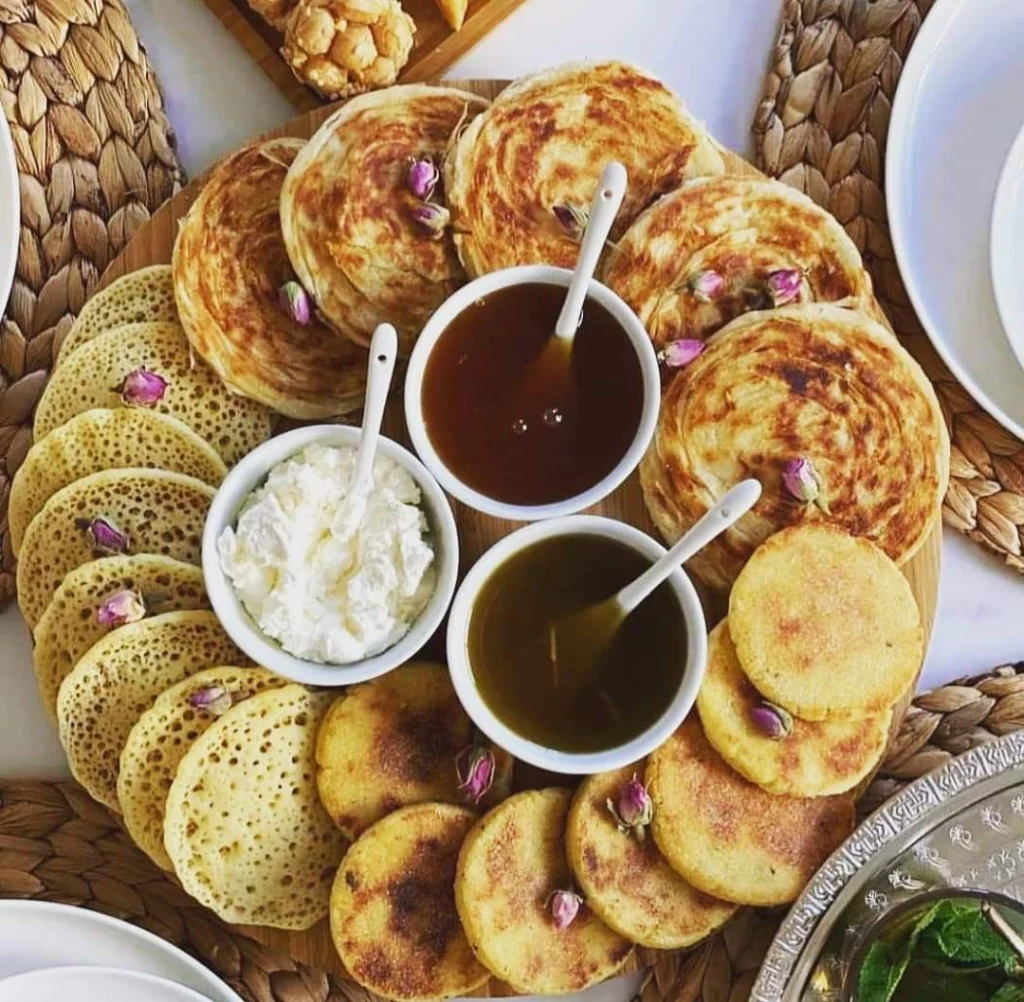
Hidden Breakfast Gems
- Cafe du Livre (Rue de la Liberté): A book-lined café serving a fusion of Moroccan and international breakfast options. Try their shakshuka with freshly baked bread.
- Al Jawda (Avenue Mohammed V): Where locals queue for the city’s flakiest msemen and harcha (semolina bread).
- Le Petit Cornichon (Gueliz): A charming spot blending French pastries with Moroccan breakfast classics.
Street Food Safari: Navigating the Culinary Backstreets
The true heart of Marrakech beats in its street food scene. From sizzling grills to steaming cauldrons, the city’s street vendors are the keepers of recipes passed down through generations. Let’s explore this vibrant world of flavors, aromas, and culinary craftsmanship.
Street Food Essentials
- Tangia Marrakchia: Unlike its cousin the tagine, tangia is a distinctly Marrakchi specialty. This clay urn slow-cooks lamb with preserved lemon, saffron, and cumin in the hot ashes of the hammam (public bathhouse) fires. The meat becomes so tender it falls off the bone with just a gentle touch.
- Merguez: These spicy lamb sausages are a street food institution. Watch for vendors who grill them fresh over charcoal, serving them hot in khobz with a side of harissa and grilled vegetables. The best ones have a satisfying snap when you bite into them, revealing a perfectly spiced interior.
- B’stilla on the Go: While traditionally a formal dish, street vendors have perfected handheld versions of this sweet-savory pie. Layers of crispy warqa pastry enclose spiced chicken (or pigeon in upscale restaurants) and ground almonds, dusted with cinnamon and powdered sugar.
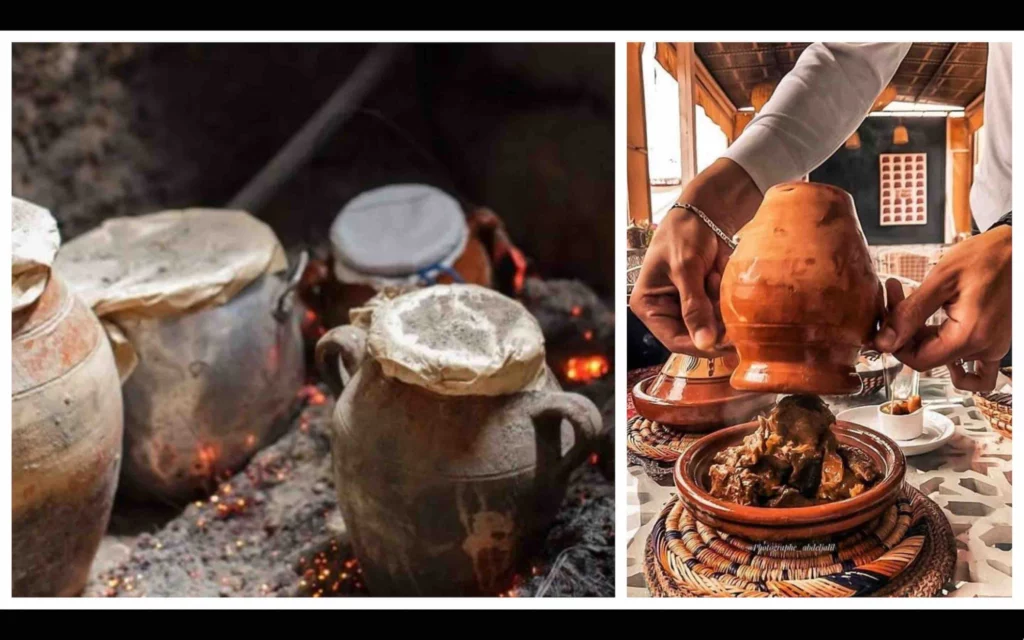
Hidden Gems and Local Favorites
Best Street Food Locations:
- Bab Doukkala Market:
- Peak hours: 11 AM – 2 PM
- Known for: Fresh vegetable juices and grilled sardines
- Local tip: Look for the vendor with the blue awning who’s been there for 30 years
- Rue Dar el Bacha:
- Specialty: Freshly fried sfenj (Moroccan doughnuts)
- Time to visit: Early morning for breakfast
- What to try: Dip them in honey while they’re still hot
- Mechoui Alley:
- Famous for: Underground-roasted lamb
- Best time: Lunch (arrives fresh at 11 AM)
- How to order: Ask for a mix of lean and fatty meat
The Art of Dining in Djemaa el-Fna
As the sun sets, Marrakech’s main square transforms into the largest open-air restaurant in Africa. Here’s your complete strategy for navigating this sensory wonderland.
Time Your Visit Right
- Sunset Hour (6-7 PM): Watch the square come alive as food stalls are assembled with practiced precision
- Peak Dining Time (8-10 PM): Experience the full spectacle of smoke, sound, and flavor
- Late Night (After 11 PM): Perfect for snacks and people-watching
Stall Selection Strategy
Look for these signs of quality:
- Stalls with numbered badges (indicating official registration)
- Clean workstations with separate preparation areas
- Vendors wearing gloves and hairnets
- Fresh ingredients displayed on ice
- High turnover of dishes
Must-Try Dishes in the Square
- Stall 32: Snail Soup
- A mineral-rich broth with tender snails
- Believed to have medicinal properties
- Served with special bread for dipping
- Stall 14: Sheep’s Head
- A local delicacy for the adventurous
- Ask for “the cheek meat” – a prized cut
- Served with cumin salt and chili sauce
- Stall 98: Grilled Seafood
- Daily deliveries from Essaouira
- Famous for its sardines with charmoula
- Try the calamari stuffed with spiced rice
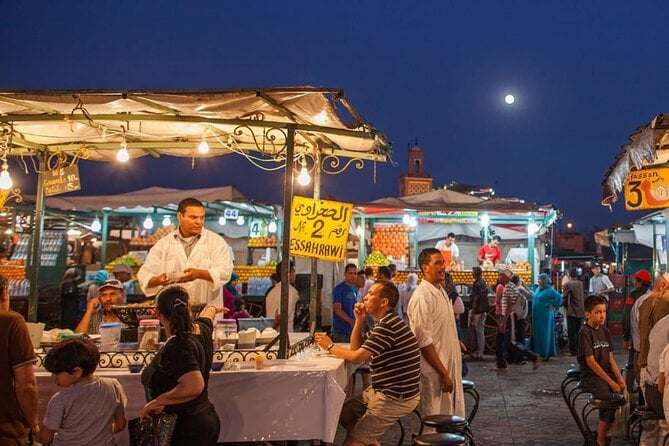
Modern Marrakech: Contemporary Dining Scene
While traditional cuisine holds strong, Marrakech’s modern restaurant scene is equally exciting, blending Moroccan flavors with international techniques.
Fine Dining Experiences
La Grande Table Marocaine
- Atmosphere: Opulent riad setting with hand-carved cedar ceilings
- Signature Dish: Seven-vegetable couscous with caramelized onions
- Wine Pairing: Moroccan wines from the Benslimane region
- Price Range: 800-1200 MAD per person
- Reservation: Book 2-3 weeks in advance
Cafe Nomad
- Setting: Rooftop terrace overlooking the spice market
- Modern Twist: Traditional dishes with contemporary presentation
- Must-Try: Calamari with chermoula and preserved lemon
- Vegetarian Options: Extensive and creative
- Booking Tip: Request a sunset table
Fusion Innovations
Modern chefs are reimagining traditional dishes:
- Tagine-inspired risotto with saffron and preserved lemon
- Moroccan-spiced sushi rolls
- Pastilla with duck confit and fig jam
- Amlou ice cream with argan brittle
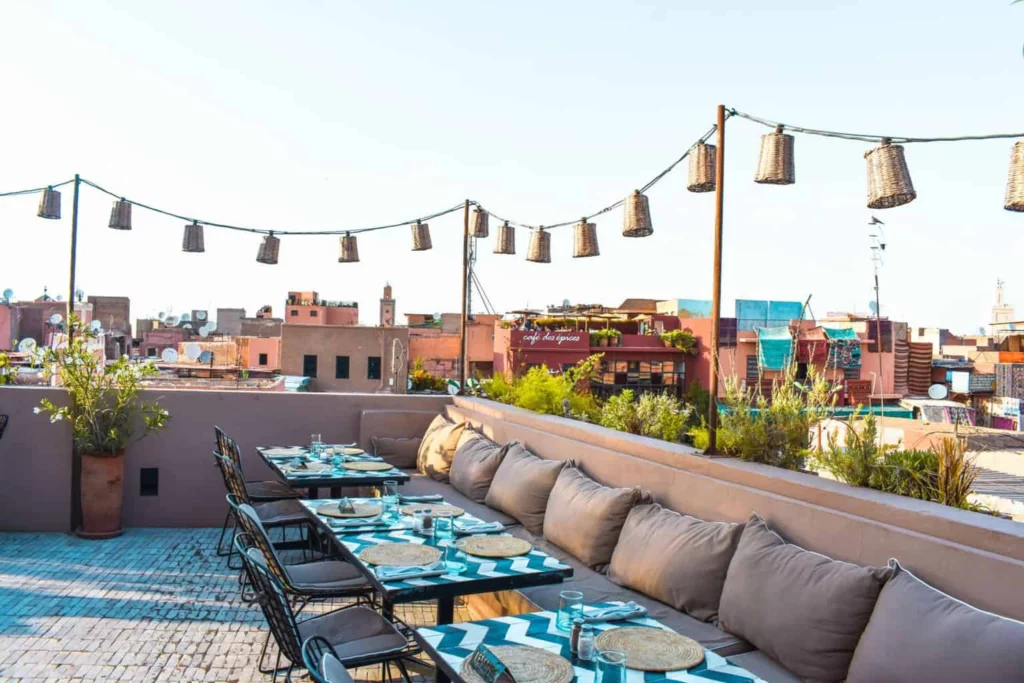
Seasonal Specialties and Festivals
Spring (March-May)
- Fresh fava beans in olive oil
- Green almond season
- Strawberry season in nearby Kenitra
- Special Ramadan treats (dates vary yearly)
Summer (June-August)
- Fresh figs from the Atlas Mountains
- Watermelon and melon season
- Cold soups and salads
- Grilled sardines from the coast
Autumn (September-November)
- Pomegranate season
- New olive oil pressing
- Fresh dates
- Quince preserves
Winter (December-February)
- Citrus season
- Traditional harira soup
- Hot street snacks
- Seasonal wild mushrooms
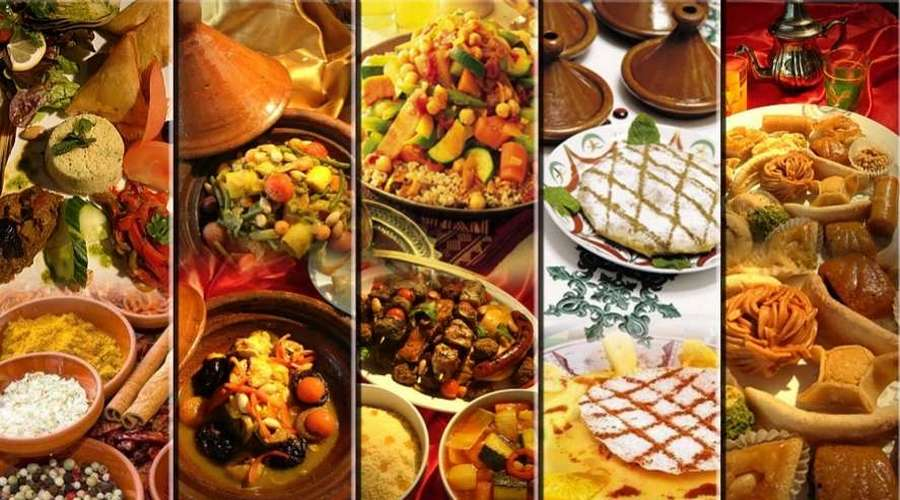
The Art of Tea and Coffee Culture
Traditional Mint Tea Ceremony
- The Perfect Pour: Learn the art of pouring from height
- Tea Varieties: Beyond mint – try sage, wormwood, or verbena
- Time of Day: Different blends for morning, afternoon, and evening
- Social Etiquette: The importance of three glasses
Modern Café Culture
New Wave Coffee Shops
- Plus61:
- Australian-style coffee
- Moroccan breakfast with a modern twist
- Popular with digital nomads
- Bacha Coffee:
- Colonial-era atmosphere
- A lot of coffee varieties
- Traditional Moroccan pastries
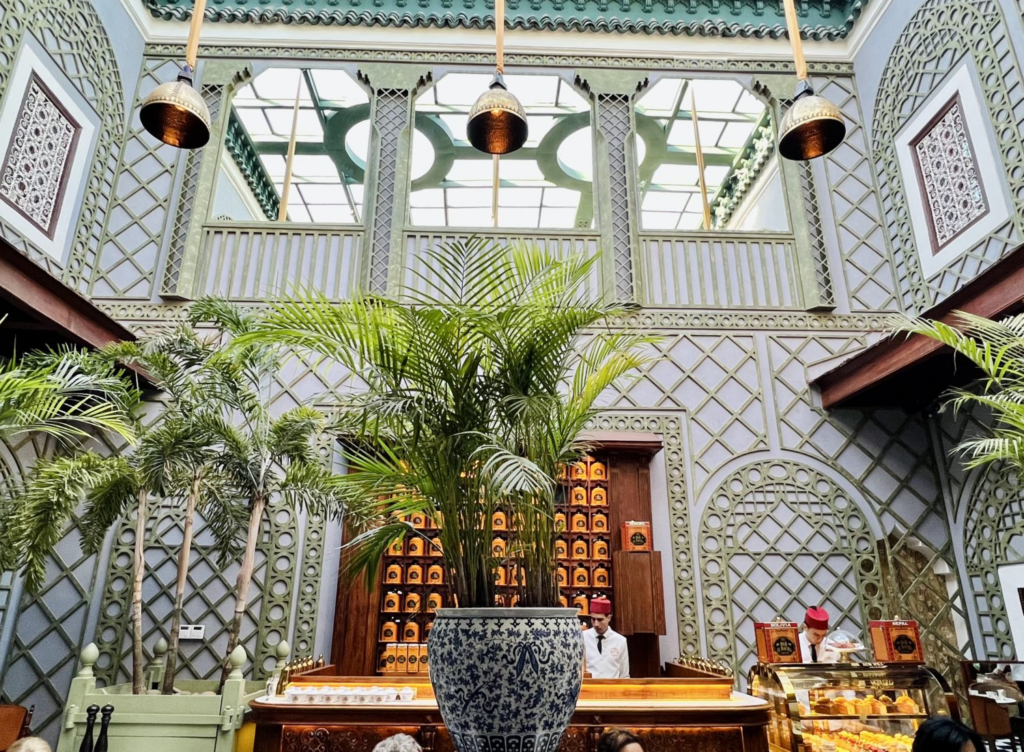
Essential Dishes You Must Try
Traditional Must-Eats
- Tagine: The city’s signature dish. Best options:
- Lamb with prunes and almonds
- Chicken with preserved lemon and olives
- Kefta (meatballs) with eggs
- B’stilla: Sweet-savory pie with layers of pastry, spiced meat, and almonds
- Couscous: Traditionally served on Fridays, best eaten at local family restaurants
- Tanjia: Marrakech’s special meat dish, slow-cooked in clay urns
Street Food Essentials
- Fresh Orange Juice: Available in Djemaa el-Fna, best in the morning
- Grilled Meats: Look for busy stalls with high turnover
- Snail Soup: A local delicacy, rich in flavor
- Fresh Bread: Try msemen (flatbread) and khobz (traditional bread)
Where to Eat: Top Spots
Budget-Friendly
- Djemaa el-Fna Food Stalls: Best after sunset, stick to stalls with numbers
- Mechoui Alley: For traditional roasted lamb
- Local Bakeries: For fresh breakfast pastries
Mid-Range
- Nomad: Modern Moroccan cuisine with rooftop views
- Café Clock: Famous for camel burgers and fusion dishes
- Amal Women’s Center: Excellent traditional food supporting a good cause
High-End
- La Grande Table Marocaine: Fine dining Moroccan cuisine
- Al Fassia: Traditional Moroccan dishes, run entirely by women
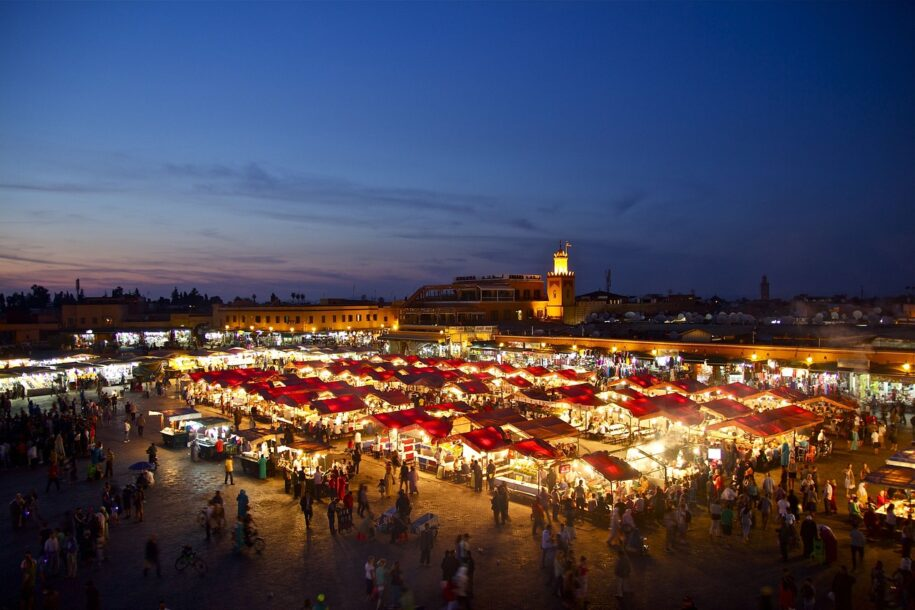
Food Safety Tips
Do’s
- Eat at busy establishments
- Choose freshly cooked, hot food
- Drink bottled water
- Try fresh orange juice from clean stalls
- Eat at restaurants recommended by locals
Don’ts
- Avoid raw vegetables unless at high-end restaurants
- Skip pre-prepared tagines in tourist areas
- Don’t eat unpeeled fruits
- Avoid ice in drinks at street stalls
Cultural Etiquette
Essential Tips
- Eat with your right hand
- Wait for the host to start eating
- Try everything offered (it’s polite)
- Say “Bismillah” before eating
Best Times to Visit
- Morning: Fresh bread and pastries
- Lunch: Local restaurants for best prices
- Evening: Djemaa el-Fna food stalls
- Ramadan: Special seasonal treats but check restaurant timing
Quick Shopping Guide
What to Buy
- Spices from reputable shops
- Argan oil from women’s cooperatives
- Local honey
- Preserved lemons
Where to Buy
- Spice Souk for cooking ingredients
- Mellah (Jewish Quarter) for olives and pickles
- Local markets for fresh produce
Final Tips
Marrakech’s food scene is a journey through centuries of culinary tradition. Whether you’re sampling street food or dining in riads, each meal offers a chance to experience the city’s rich cultural heritage. Focus on fresh, well-cooked foods from reputable vendors, and don’t be afraid to explore beyond the tourist trails for authentic flavors.

